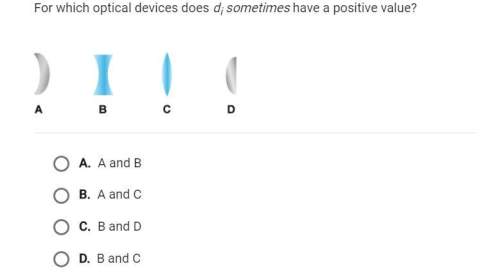When the sun shines on your face, you feel warmth from its
radiation
conduction
c...

Physics, 25.08.2019 17:20 zistoe0430
When the sun shines on your face, you feel warmth from its
radiation
conduction
convection
condensation

Answers: 1


Another question on Physics

Physics, 21.06.2019 14:00
Two red blood cells each have a mass of 9.0 multiply.gif 10-14 kg and carry a negative charge spread uniformly over their surfaces. the repulsion arising from the excess charge prevents the cells from clumping together. one cell carries −2.50 pc of charge and the other −3.10 pc, and each cell can be modeled as a sphere 7.5 μm in diameter. (a) what speed would they need when very far away from each other to get close enough to just touch? assume that there is no viscous drag from any of the surrounding liquid. answer is: 321 m/s how do i find this (b) what is the maximum acceleration of the cells in part (a)? answer is: 1.38e+10 m/s2 how did they find this answer
Answers: 2

Physics, 21.06.2019 22:30
Follow these directions and answer the questions. 1. shine a pencil-thin beam of light on a mirror perpendicular to its surface. (if you don't have a laser light as suggested in the video, you can make a narrow beam from a flashlight by making a cone from black construction paper and taping it over the face of the flashlight.) how does the light reflect? how does the relationship of incident to reflected ray relate to the reflection of water waves moving perpendicular to a barrier? 2. shine a pencil-thin beam of light on a mirror standing on a sheet of paper on the table (or floor) so that you can mark the incident ray and reflected ray. (you can support the mirror from the back by taping it to a wooden block.) 3. mark a line on the paper representing the reflective surface. (the reflective surface of a mirror is usually the back edge.) 4. draw a dashed line perpendicular to the mirror surface at a point where the incident and reflected ray meet. this perpendicular is called a normal to the surface. 5. measure the angles between the rays and the normal. the angle of incidence is the angle formed by the incident ray and the normal to the surface. the angle formed by the reflected ray and normal is called the angle of reflection (r). what is the angle of incidence? what is the angle of reflection? 6. repeat for several different angles. (see report sheet for details.) what appears to be the relationship between the angle of incidence and angle of reflection? in science 1204, what was the relationship for these two angles made by the reflection of waves in a ripple tank? 7. roll a ball bearing so that it hits a fixed, hard surface (a metal plate) at several angles (including head-on). observe the way in which the ball bearing reflects. what generalization can you make about how a ball bearing reflects from a wall? have you proved that light can only behave like a wave?
Answers: 1

Physics, 22.06.2019 10:30
In automobile steering wheel is shown what is the ideal mechanical advantage blank? if the ama is eight what is the efficiency of the steering wheel?
Answers: 1

Physics, 22.06.2019 14:10
Match these items. 1. coulombs __force 2. ohms __emf 3. centimeters __resistance 4. newtons __charge 5. volts __length
Answers: 1
You know the right answer?
Questions

Mathematics, 24.02.2021 01:30

Business, 24.02.2021 01:30


Mathematics, 24.02.2021 01:30

Mathematics, 24.02.2021 01:30

Mathematics, 24.02.2021 01:30





Chemistry, 24.02.2021 01:30






Mathematics, 24.02.2021 01:30






